Copper-clad laminate is also known as base material. It is a plate-like material formed by hot pressing by impregnating a reinforcing material with resin and covering one or both sides with copper foil, which is called a copper-clad laminate. It is the basic material for PCB, often called substrate. When it is used in the production of multilayer boards, it is also called core board (CORE). This article mainly introduces the process flow of high-speed and high-frequency copper clad laminates. Please follow the editor to learn more about it.
High-speed and high-frequency PCB copper clad laminate process
The preparation process of high frequency copper clad laminate is similar to that of ordinary copper clad laminate:
1. Glue mixing: The special resin, solvent, and filler are pumped into the glue mixing tank through a pipeline according to a certain proportion and stirred. The materials need to be stirred to prepare a viscous glue with fluidity.
2. Gluing and drying: pump the mixed glue into the glue tank, and at the same time continuously immerse the glass fiber cloth into the glue tank through the gluing machine to make the glue adhere to the glass fiber cloth. The glued glass fiber cloth enters the glue machine oven and is dried at high temperature to become a bonded sheet.
3. Stack the book after cutting the sticky slices: The dried sticky slices are trimmed as required, and the sticky slices (1 or more) and copper foil are stacked and transported to the clean room. Use an automatic book machine to combine the prepared material and the mirror steel plate.
4. Laminating: Send the assembled semi-finished product from the automatic conveyor to the hot press for hot pressing, so that the product can be kept in a high temperature, high pressure and vacuum environment for several hours, so that the bonding sheet and the copper foil are connected together, and finally It becomes the finished copper clad laminate with surface copper foil and intermediate insulating layer.
5. Cutting board: After cooling, trim the extra side strips of the disassembled product, and cut it into corresponding size according to customer requirements.
Process analysis of high-speed and high-frequency copper clad laminates
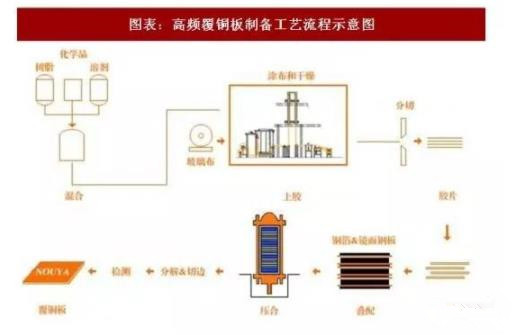
Chart: Schematic diagram of high-frequency copper clad laminate preparation process
The raw material formula directly affects the dielectric constant and dielectric loss of the copper clad laminate. The core difficulty of the process production lies in the selection of upstream raw materials and the formula ratio:
Resin:
Traditional epoxy resin has higher dielectric properties due to its higher content of polar groups. By using other types of resins such as polytetrafluoroethylene, cyanate ester, styrene maleic anhydride, PPO/APPE and other modifications Low-polarization molecular structures such as thermosetting plastics to achieve low-dielectric constant and low-loss materials.
Process analysis of high-speed and high-frequency copper clad laminates
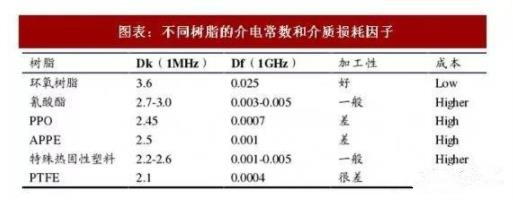
Chart: Dielectric constant and dielectric loss factor of different resins
Filler: Improve the physical properties of the board while affecting the dielectric constant
Filling materials in the manufacture of substrate materials refer to chemical materials used as resin fillers in addition to reinforcing fiber materials in the composition of substrate materials. The proportion, variety, and surface treatment technology of the filler material in the resin for the entire substrate material all have an impact on the dielectric constant of the substrate material. The more commonly used inorganic fillers are: talc, kaolin, magnesium hydroxide, aluminum hydroxide, silica powder and alumina. The addition of fillers can effectively reduce the moisture absorption of the product, thereby improving the heat resistance of the board, and at the same time, it can also reduce the thermal expansion coefficient of the board.
Process analysis of high-speed and high-frequency copper clad laminates
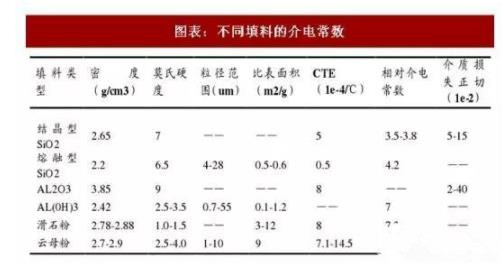
Chart: Dielectric constant of different fillers
Glass fiber cloth: reducing the dielectric constant of glass fiber cloth is an effective way to reduce the dielectric constant of the sheet
Glass fiber cloth is the main bearer of the mechanical strength of the copper clad laminate. Generally speaking, its dielectric constant is higher than the resin matrix, and it occupies a higher volume content in the copper clad laminate, so it is the main factor that determines the dielectric properties of the composite material. In the production of FR-4 copper clad laminates, traditional E-glass fiber cloth has been used. Although E-glass fiber cloth has good overall performance and ideal performance and price, its dielectric performance is not good and the dielectric constant is relatively high (6.6), Which has affected its popularization and application in the high-frequency and high-speed field. At present, glass fiber cloth manufacturers are also developing low-dielectric constant organic fibers, such as aramid fibers, polyether ether ketone (PEEK) fibers and acetate fibers.
Process analysis of high-speed and high-frequency copper clad laminates
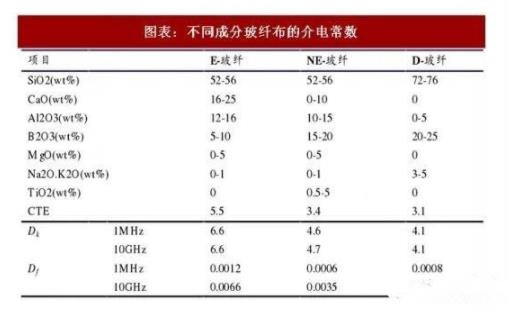
Chart: Dielectric constants of different components of glass fiber cloth
Copper foil: The surface roughness of copper foil also affects the properties of the material
The skin depth of copper foil decreases as the signal transmission inland increases. At high frequencies, the skin depth of copper conductors is less than 1um, which means that most circuits will flow through the tooth-like structure on the surface of the copper foil due to the rough surface. Influencing the flow of current will affect the power loss and insertion loss.
Process analysis of high-speed and high-frequency copper clad laminates
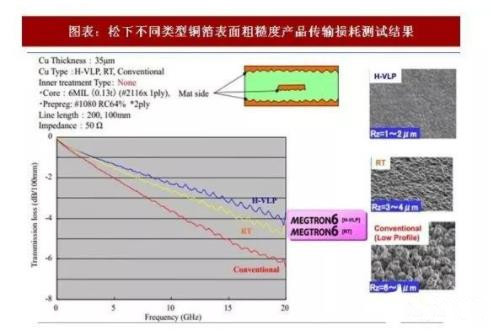
Chart: Transmission loss test results of different types of copper foil surface roughness products of Panasonic
The preparation process of high-frequency copper clad laminates is similar to that of conventional products. The dielectric constant and dielectric loss are mainly affected by raw materials, process recipes, and process control. The above three factors require long-term downstream application product verification and experimental experience accumulation. Core barriers for manufacturers of high-frequency copper clad laminates.